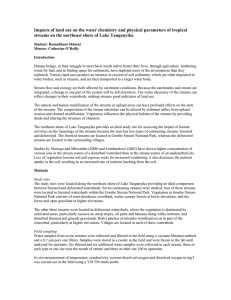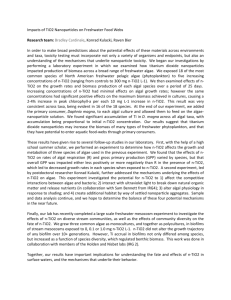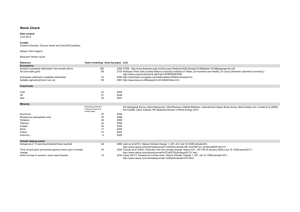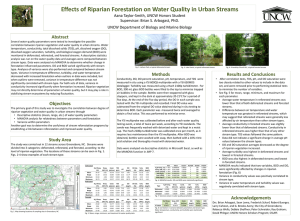Nutrient Limitation in Tropical Streams of Tanzania Introduction
advertisement
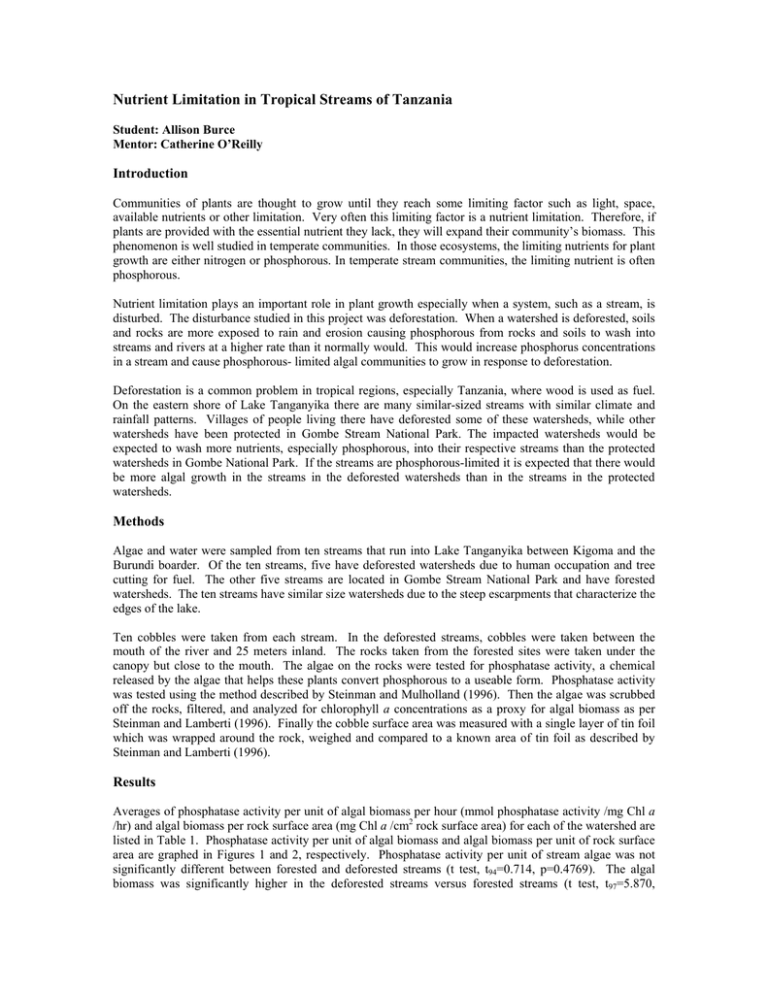
Nutrient Limitation in Tropical Streams of Tanzania Student: Allison Burce Mentor: Catherine O’Reilly Introduction Communities of plants are thought to grow until they reach some limiting factor such as light, space, available nutrients or other limitation. Very often this limiting factor is a nutrient limitation. Therefore, if plants are provided with the essential nutrient they lack, they will expand their community’s biomass. This phenomenon is well studied in temperate communities. In those ecosystems, the limiting nutrients for plant growth are either nitrogen or phosphorous. In temperate stream communities, the limiting nutrient is often phosphorous. Nutrient limitation plays an important role in plant growth especially when a system, such as a stream, is disturbed. The disturbance studied in this project was deforestation. When a watershed is deforested, soils and rocks are more exposed to rain and erosion causing phosphorous from rocks and soils to wash into streams and rivers at a higher rate than it normally would. This would increase phosphorus concentrations in a stream and cause phosphorous- limited algal communities to grow in response to deforestation. Deforestation is a common problem in tropical regions, especially Tanzania, where wood is used as fuel. On the eastern shore of Lake Tanganyika there are many similar-sized streams with similar climate and rainfall patterns. Villages of people living there have deforested some of these watersheds, while other watersheds have been protected in Gombe Stream National Park. The impacted watersheds would be expected to wash more nutrients, especially phosphorous, into their respective streams than the protected watersheds in Gombe National Park. If the streams are phosphorous-limited it is expected that there would be more algal growth in the streams in the deforested watersheds than in the streams in the protected watersheds. Methods Algae and water were sampled from ten streams that run into Lake Tanganyika between Kigoma and the Burundi boarder. Of the ten streams, five have deforested watersheds due to human occupation and tree cutting for fuel. The other five streams are located in Gombe Stream National Park and have forested watersheds. The ten streams have similar size watersheds due to the steep escarpments that characterize the edges of the lake. Ten cobbles were taken from each stream. In the deforested streams, cobbles were taken between the mouth of the river and 25 meters inland. The rocks taken from the forested sites were taken under the canopy but close to the mouth. The algae on the rocks were tested for phosphatase activity, a chemical released by the algae that helps these plants convert phosphorous to a useable form. Phosphatase activity was tested using the method described by Steinman and Mulholland (1996). Then the algae was scrubbed off the rocks, filtered, and analyzed for chlorophyll a concentrations as a proxy for algal biomass as per Steinman and Lamberti (1996). Finally the cobble surface area was measured with a single layer of tin foil which was wrapped around the rock, weighed and compared to a known area of tin foil as described by Steinman and Lamberti (1996). Results Averages of phosphatase activity per unit of algal biomass per hour (mmol phosphatase activity /mg Chl a /hr) and algal biomass per rock surface area (mg Chl a /cm2 rock surface area) for each of the watershed are listed in Table 1. Phosphatase activity per unit of algal biomass and algal biomass per unit of rock surface area are graphed in Figures 1 and 2, respectively. Phosphatase activity per unit of stream algae was not significantly different between forested and deforested streams (t test, t94=0.714, p=0.4769). The algal biomass was significantly higher in the deforested streams versus forested streams (t test, t97=5.870, p<0.0001). Also the standard error in phosphatase activity was greater in forested streams compared to deforested streams. Lombardozzi (2003), who studied nutrients in the same streams, found that Bwavi stream, a forested site, had very high phosphate (PO4 –3) values compared to the other forested sites and she therefore excluded Bwavi from forest averages. If the Bwavi site is excluded from the data set, the phosphatase activity is still not significantly different between forested and deforested sites (t test, t87=0.854, p=0.3956). The algal biomass is still significantly higher in deforested streams than in forested streams (t test, t87=6.721, p<0.0001). Also there is still more variation in the phosphatase activity in deforested streams and without the Bwavi data point this difference is greater. Discussion Since there was significantly higher phosphorous in deforested sites found by Lombardozzi (2003) but there was no significant difference in phosphatase activity between forested and deforested sites, the algae was not limited in its growth by phosphorous in either stream type. However, there was a higher standard error in phosphatase activity in forested sites, which indicates a greater chance for phosphorous limitation in forested streams. Bellinger (2003) also concluded that these streams were not phosphorous limited because of the presence of the diatom Nitschia in all the streams. Nitschia is associated with eutrophication and high phosphorous values in temperate aquatic systems. These results are in contrast to most work in temperate systems, where phosphorus is usually a limiting nutrient. In deforested sites there was significantly higher biomass on the stream rocks. Therefore the algae in deforested streams are receiving some nutrient or other biological parameter to stimulate their growth that is limiting the undisturbed, forested streams. N: P ratios preliminarily calculated from Lombardozzi (2003) show very low molar N: P ratios that vary from 0.03:1 to 6.9:1. It must be noted that she did not test for ammonium and therefore the nitrogen numbers are underestimates of biologically available nitrogen and therefore the N: P ratios are low. Lombardozzi will analyze ammonium in the future on the same samples as well as reanalyze the other biologically available forms of nitrogen and phosphorous. Disregarding the lack of ammonium data, these streams show very low nitrogen values and therefore could be nitrogen limited. It must also be noted that algal biomass for forested sites was calculated for rocks under the canopy while in deforested streams there was no canopy. Therefore, some of the differences between forested and deforested algal biomass may be due to light limitation as well. There is also the possibility that algal growth is limited in the forested streams because of another nutrient or another biologically important factor that was not mentioned above. However, nitrogen limitation is the most likely factor due to the very low N: P ratio as well as the human presence in deforested watersheds. Conclusions Both the forested and deforested streams on the eastern shore of Lake Tanganyika that were sampled are not phosphorous limited and are most likely nitrogen limited. No significant difference in phosphatase activity was found between forested and deforested sites even though there were significantly higher amounts of phosphorous in deforested streams (not including Bwavi data). Future Work Ash free dry mass of the material scraped off the rocks will be determined to confirm chlorophyll a values, as well as to determine the amount of organic matter on the rocks. Also N: P ratios of the streams will be retested by Lombardozzi to determine if nitrogen is low compared to phosphorous levels, as is suspected. Acknowledgements I wish to thank the US National Science Foundation Grant #ATM9619458 (The Nyanza Project) for financial support of this project. I would especially like to thank my mentor, Catherine O’Reilly for all of her guidance, support and enthusiasm during this project. I would also like to thank my fellow members of the 2003 Limnology team including our teaching assistant Willy Mbemba and the students Danica Lombardozzi, Brent Bellinger and Bob Swarthout for all their help in the field and in the lab. Lastly, I would also like to thank Andy Cohen, Ellinor Michel and everyone else who has made the Nyanza Project possible. References Steinman, A. D. and G. A. Lamberti “Biomass and Pigments of Benthic Algae” in Methods in Stream Ecology (Academic Press, 1996). Steinman, A. D. and P. J. Mulholland “Phosphorous Limitation, Uptake and Turnover in Stream Algae” in Methods in Stream Ecology (Academic Press, 1996). Lombardozzi D., 2003, The Effects of Deforestation on Nutrient Concentrations in Tributaries of Lake Tanganyika. Nyanza Project 2003 Annual Report (this volume). Bellinger B., 2003, Lotic Diatoms as Environmental Indicators for Modern and Paleo Studies. Nyanza Project 2003 Annual Report (this volume). Table 1: Phosphatase activity per unit of algal biomass and algal biomass per unit rock area averaged for ten rocks from each watershed. The ten watersheds are listed in order from south to north. Phosphatase Activity (mmol/mg Chla/hr) Watershed Type of Watershed Mean Standard Error Bwavi Forested 0.0327 0.0168 Mkenke Forested 0.0918 0.0328 Kasakera Forested 0.0379 0.0037 Rutanga Forested 0.0913 0.0558 Mitumba Forested 0.0190 0.0027 Mtanga Deforested 0.0602 0.0088 Mtanga A Deforested 0.0274 0.0066 Mwongongo Deforested 0.0488 0.0068 Bugamba Deforested 0.0280 0.0027 Kiziba Deforested 0.0696 0.0177 Algal Biomass (mg/cm2) Mean Standard Error 0.3062 0.1361 0.0600 0.0147 0.0759 0.0099 0.1167 0.0308 0.1956 0.0290 0.6062 0.1350 0.6520 0.1534 0.2794 0.0371 0.5521 0.0945 0.3761 0.0695 0.16 0.14 0.12 0.10 0.08 0.06 0.04 0.02 0.00 M M ta n ta ga ng a A Bw M avi ke Ka nk sa e ke R ra ut a M nga M itum w on ba Al go lD Bu ng ef ga o o Al res m l F te ba or d K es W izi te ate ba d W rsh at ed er sh s ed s Phosphatase Activity (mmol/mg Chla/hr) Mean Phosphatase Activity in Streams and Watershed Types Figure 1: Average phosphatase activity per mg of algal biomass for each watershed (deforested and forested watersheds, respectively). Striped bars are deforested and gray bars are forested watersheds. 1.0 0.8 0.6 0.4 0.2 ga M ta ng a A Bw av i M ke n Ka ke sa ke ra R ut an ga M itu m M ba w on go ng Al B lD ug o am ef or ba Al este K lF d or W izib es at a er te sh d W ed at s er sh ed s 0.0 M ta n Algal Biomass (mg/cm2 Mean Algal Biomass in Streams and Watershed Types Figure 2: Average mg of algal biomass per square cm of rock surface area for each watershed (deforested and forested watersheds, respectively). Striped bars are deforested and gray bars are forested watersheds.
